Raja Jurdak
H-FLTN: A Privacy-Preserving Hierarchical Framework for Electric Vehicle Spatio-Temporal Charge Prediction
Feb 25, 2025Abstract:The widespread adoption of Electric Vehicles (EVs) poses critical challenges for energy providers, particularly in predicting charging time (temporal prediction), ensuring user privacy, and managing resources efficiently in mobility-driven networks. This paper introduces the Hierarchical Federated Learning Transformer Network (H-FLTN) framework to address these challenges. H-FLTN employs a three-tier hierarchical architecture comprising EVs, community Distributed Energy Resource Management Systems (DERMS), and the Energy Provider Data Centre (EPDC) to enable accurate spatio-temporal predictions of EV charging needs while preserving privacy. Temporal prediction is enhanced using Transformer-based learning, capturing complex dependencies in charging behavior. Privacy is ensured through Secure Aggregation, Additive Secret Sharing, and Peer-to-Peer (P2P) Sharing with Augmentation, which allow only secret shares of model weights to be exchanged while securing all transmissions. To improve training efficiency and resource management, H-FLTN integrates Dynamic Client Capping Mechanism (DCCM) and Client Rotation Management (CRM), ensuring that training remains both computationally and temporally efficient as the number of participating EVs increases. DCCM optimises client participation by limiting excessive computational loads, while CRM balances training contributions across epochs, preventing imbalanced participation. Our simulation results based on large-scale empirical vehicle mobility data reveal that DCCM and CRM reduce the training time complexity with increasing EVs from linear to constant. Its integration into real-world smart city infrastructure enhances energy demand forecasting, resource allocation, and grid stability, ensuring reliability and sustainability in future mobility ecosystems.
Countering Backdoor Attacks in Image Recognition: A Survey and Evaluation of Mitigation Strategies
Nov 17, 2024Abstract:The widespread adoption of deep learning across various industries has introduced substantial challenges, particularly in terms of model explainability and security. The inherent complexity of deep learning models, while contributing to their effectiveness, also renders them susceptible to adversarial attacks. Among these, backdoor attacks are especially concerning, as they involve surreptitiously embedding specific triggers within training data, causing the model to exhibit aberrant behavior when presented with input containing the triggers. Such attacks often exploit vulnerabilities in outsourced processes, compromising model integrity without affecting performance on clean (trigger-free) input data. In this paper, we present a comprehensive review of existing mitigation strategies designed to counter backdoor attacks in image recognition. We provide an in-depth analysis of the theoretical foundations, practical efficacy, and limitations of these approaches. In addition, we conduct an extensive benchmarking of sixteen state-of-the-art approaches against eight distinct backdoor attacks, utilizing three datasets, four model architectures, and three poisoning ratios. Our results, derived from 122,236 individual experiments, indicate that while many approaches provide some level of protection, their performance can vary considerably. Furthermore, when compared to two seminal approaches, most newer approaches do not demonstrate substantial improvements in overall performance or consistency across diverse settings. Drawing from these findings, we propose potential directions for developing more effective and generalizable defensive mechanisms in the future.
Unlearning Backdoor Attacks through Gradient-Based Model Pruning
May 07, 2024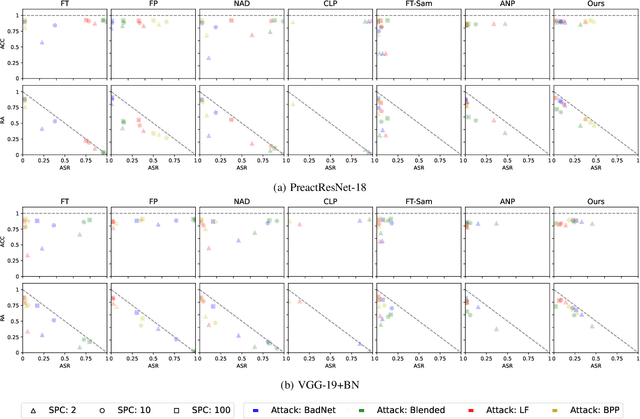
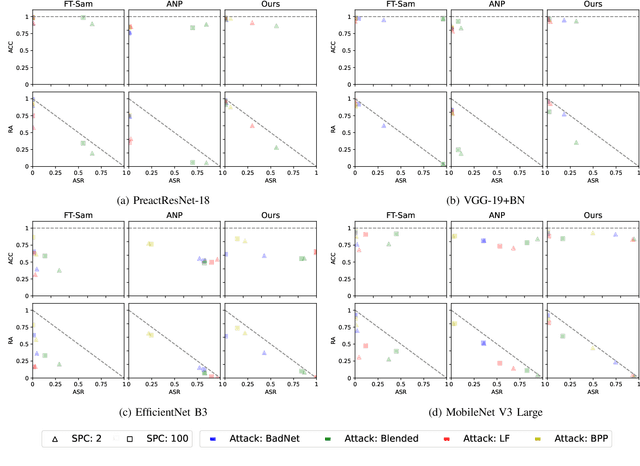
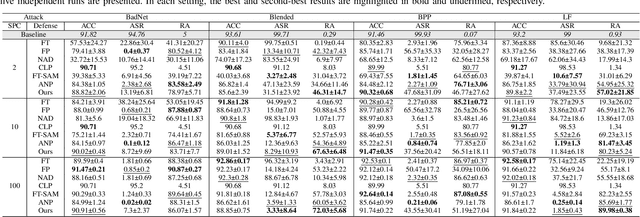
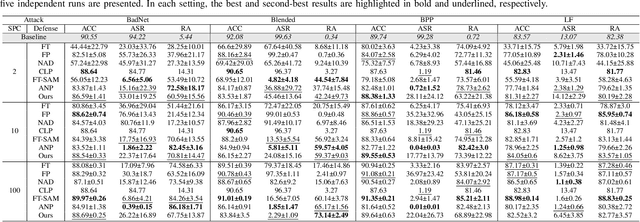
Abstract:In the era of increasing concerns over cybersecurity threats, defending against backdoor attacks is paramount in ensuring the integrity and reliability of machine learning models. However, many existing approaches require substantial amounts of data for effective mitigation, posing significant challenges in practical deployment. To address this, we propose a novel approach to counter backdoor attacks by treating their mitigation as an unlearning task. We tackle this challenge through a targeted model pruning strategy, leveraging unlearning loss gradients to identify and eliminate backdoor elements within the model. Built on solid theoretical insights, our approach offers simplicity and effectiveness, rendering it well-suited for scenarios with limited data availability. Our methodology includes formulating a suitable unlearning loss and devising a model-pruning technique tailored for convolutional neural networks. Comprehensive evaluations demonstrate the efficacy of our proposed approach compared to state-of-the-art approaches, particularly in realistic data settings.
A Preliminary Study on Augmenting Speech Emotion Recognition using a Diffusion Model
May 19, 2023Abstract:In this paper, we propose to utilise diffusion models for data augmentation in speech emotion recognition (SER). In particular, we present an effective approach to utilise improved denoising diffusion probabilistic models (IDDPM) to generate synthetic emotional data. We condition the IDDPM with the textual embedding from bidirectional encoder representations from transformers (BERT) to generate high-quality synthetic emotional samples in different speakers' voices\footnote{synthetic samples URL: \url{https://emulationai.com/research/diffusion-ser.}}. We implement a series of experiments and show that better quality synthetic data helps improve SER performance. We compare results with generative adversarial networks (GANs) and show that the proposed model generates better-quality synthetic samples that can considerably improve the performance of SER when augmented with synthetic data.
Emotions Beyond Words: Non-Speech Audio Emotion Recognition With Edge Computing
May 01, 2023Abstract:Non-speech emotion recognition has a wide range of applications including healthcare, crime control and rescue, and entertainment, to name a few. Providing these applications using edge computing has great potential, however, recent studies are focused on speech-emotion recognition using complex architectures. In this paper, a non-speech-based emotion recognition system is proposed, which can rely on edge computing to analyse emotions conveyed through non-speech expressions like screaming and crying. In particular, we explore knowledge distillation to design a computationally efficient system that can be deployed on edge devices with limited resources without degrading the performance significantly. We comprehensively evaluate our proposed framework using two publicly available datasets and highlight its effectiveness by comparing the results with the well-known MobileNet model. Our results demonstrate the feasibility and effectiveness of using edge computing for non-speech emotion detection, which can potentially improve applications that rely on emotion detection in communication networks. To the best of our knowledge, this is the first work on an edge-computing-based framework for detecting emotions in non-speech audio, offering promising directions for future research.
Multitask Learning from Augmented Auxiliary Data for Improving Speech Emotion Recognition
Jul 12, 2022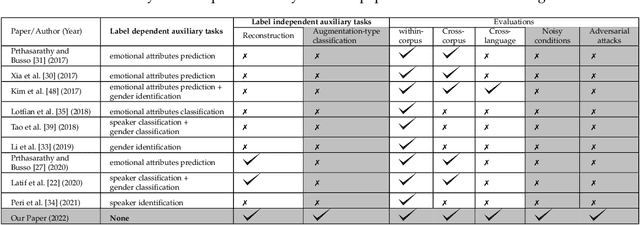
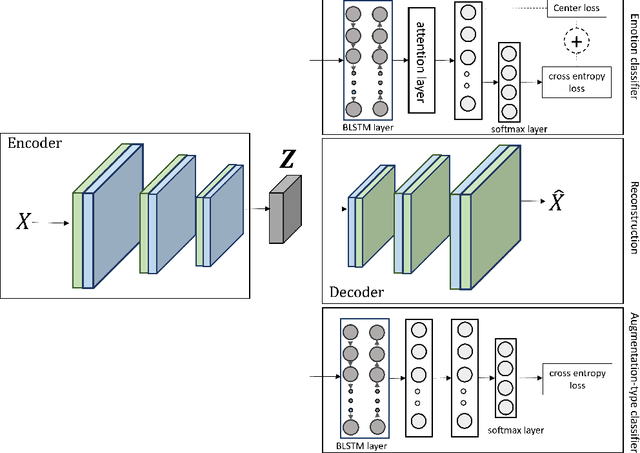
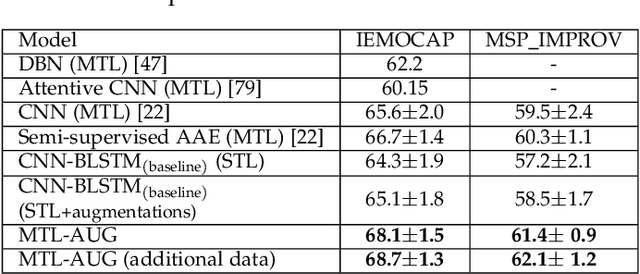

Abstract:Despite the recent progress in speech emotion recognition (SER), state-of-the-art systems lack generalisation across different conditions. A key underlying reason for poor generalisation is the scarcity of emotion datasets, which is a significant roadblock to designing robust machine learning (ML) models. Recent works in SER focus on utilising multitask learning (MTL) methods to improve generalisation by learning shared representations. However, most of these studies propose MTL solutions with the requirement of meta labels for auxiliary tasks, which limits the training of SER systems. This paper proposes an MTL framework (MTL-AUG) that learns generalised representations from augmented data. We utilise augmentation-type classification and unsupervised reconstruction as auxiliary tasks, which allow training SER systems on augmented data without requiring any meta labels for auxiliary tasks. The semi-supervised nature of MTL-AUG allows for the exploitation of the abundant unlabelled data to further boost the performance of SER. We comprehensively evaluate the proposed framework in the following settings: (1) within corpus, (2) cross-corpus and cross-language, (3) noisy speech, (4) and adversarial attacks. Our evaluations using the widely used IEMOCAP, MSP-IMPROV, and EMODB datasets show improved results compared to existing state-of-the-art methods.
Self Supervised Adversarial Domain Adaptation for Cross-Corpus and Cross-Language Speech Emotion Recognition
Apr 19, 2022



Abstract:Despite the recent advancement in speech emotion recognition (SER) within a single corpus setting, the performance of these SER systems degrades significantly for cross-corpus and cross-language scenarios. The key reason is the lack of generalisation in SER systems towards unseen conditions, which causes them to perform poorly in cross-corpus and cross-language settings. Recent studies focus on utilising adversarial methods to learn domain generalised representation for improving cross-corpus and cross-language SER to address this issue. However, many of these methods only focus on cross-corpus SER without addressing the cross-language SER performance degradation due to a larger domain gap between source and target language data. This contribution proposes an adversarial dual discriminator (ADDi) network that uses the three-players adversarial game to learn generalised representations without requiring any target data labels. We also introduce a self-supervised ADDi (sADDi) network that utilises self-supervised pre-training with unlabelled data. We propose synthetic data generation as a pretext task in sADDi, enabling the network to produce emotionally discriminative and domain invariant representations and providing complementary synthetic data to augment the system. The proposed model is rigorously evaluated using five publicly available datasets in three languages and compared with multiple studies on cross-corpus and cross-language SER. Experimental results demonstrate that the proposed model achieves improved performance compared to the state-of-the-art methods.
What's in the Black Box? The False Negative Mechanisms Inside Object Detectors
Mar 15, 2022



Abstract:In object detection, false negatives arise when a detector fails to detect a target object. To understand why object detectors produce false negatives, we identify five 'false negative mechanisms', where each mechanism describes how a specific component inside the detector architecture failed. Focusing on two-stage and one-stage anchor-box object detector architectures, we introduce a framework for quantifying these false negative mechanisms. Using this framework, we investigate why Faster R-CNN and RetinaNet fail to detect objects in benchmark vision datasets and robotics datasets. We show that a detector's false negative mechanisms differ significantly between computer vision benchmark datasets and robotics deployment scenarios. This has implications for the translation of object detectors developed for benchmark datasets to robotics applications.
Exploring Deep Neural Networks on Edge TPU
Oct 20, 2021



Abstract:This paper explores the performance of Google's Edge TPU on feed forward neural networks. We consider Edge TPU as a hardware platform and explore different architectures of deep neural network classifiers, which traditionally has been a challenge to run on resource constrained edge devices. Based on the use of a joint-time-frequency data representation, also known as spectrogram, we explore the trade-off between classification performance and the energy consumed for inference. The energy efficiency of Edge TPU is compared with that of widely-used embedded CPU ARM Cortex-A53. Our results quantify the impact of neural network architectural specifications on the Edge TPU's performance, guiding decisions on the TPU's optimal operating point, where it can provide high classification accuracy with minimal energy consumption. Also, our evaluations highlight the crossover in performance between the Edge TPU and Cortex-A53, depending on the neural network specifications. Based on our analysis, we provide a decision chart to guide decisions on platform selection based on the model parameters and context.
Exploring Edge TPU for Network Intrusion Detection in IoT
Mar 30, 2021



Abstract:This paper explores Google's Edge TPU for implementing a practical network intrusion detection system (NIDS) at the edge of IoT, based on a deep learning approach. While there are a significant number of related works that explore machine learning based NIDS for the IoT edge, they generally do not consider the issue of the required computational and energy resources. The focus of this paper is the exploration of deep learning-based NIDS at the edge of IoT, and in particular the computational and energy efficiency. In particular, the paper studies Google's Edge TPU as a hardware platform, and considers the following three key metrics: computation (inference) time, energy efficiency and the traffic classification performance. Various scaled model sizes of two major deep neural network architectures are used to investigate these three metrics. The performance of the Edge TPU-based implementation is compared with that of an energy efficient embedded CPU (ARM Cortex A53). Our experimental evaluation shows some unexpected results, such as the fact that the CPU significantly outperforms the Edge TPU for small model sizes.
 Add to Chrome
Add to Chrome Add to Firefox
Add to Firefox Add to Edge
Add to Edge